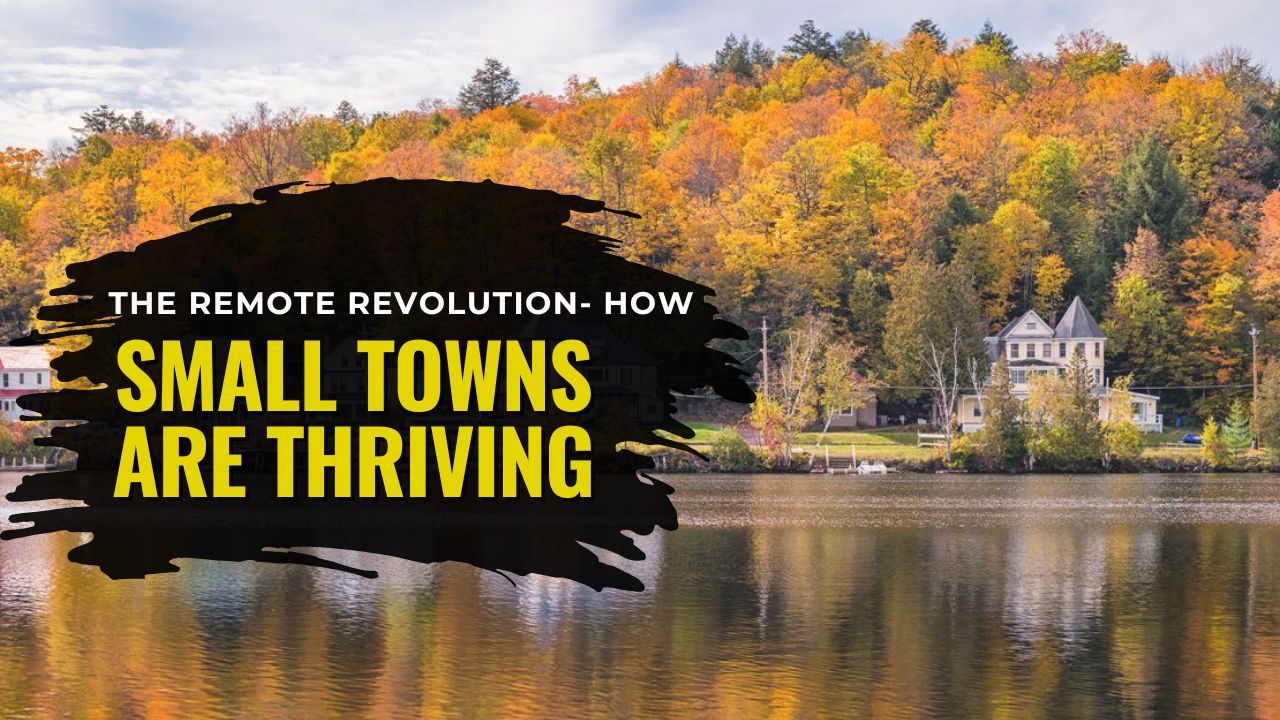The remote work shift didn’t fade after office reopenings—it matured. In 2025, a durable mix of fully remote and hybrid jobs is helping families choose lifestyle first and commute last.
That’s great news for small towns, which are attracting professionals with lower living costs, stronger community ties, and access to nature—all while upgrading broadband, co-working, and downtown amenities.
Below, we unpack the key drivers, the numbers that matter, and a practical playbook for communities that want to keep the momentum going.
The New Normal- Flexibility is baked into the labor market
Even as some large firms toughen return-to-office rules, the overall mix has settled into a stable pattern:
- A solid base of workers is fully remote (roughly one in ten employees).
- A larger block is hybrid (roughly one in four to one in three), splitting time between home and office.
- The remainder is on-site, concentrated in hands-on roles.
Why that matters for small towns: this structure gives millions of people permission to live where life works, not just where the office sits.
As long as reliable high-speed internet is available, professionals can bring big-city paychecks to small-town main streets.
What’s Fueling the Boom in Small Towns
1) Broadband as basic infrastructure.
The single biggest unlock has been faster, more reliable internet. Towns that pursued fiber builds, public-private partnerships, and last-mile solutions have flipped from “too far away” to “perfectly connected.” Minimum targets are increasingly future-proof speeds that support video calls, cloud apps, and multiple devices per household.
2) Talent-attraction programs.
Move-in incentives paired with co-working memberships, community onboarding, and housing assistance help newcomers land quickly.
The best programs don’t just hand out grants— they build social capital through welcome events, mentorship, and volunteer pathways, making it easy to form genuine ties within the first 90 days.
3) Quality of life + affordability.
Smaller places win on space, safety, schools, and outdoor recreation.
Even where home prices have risen, many towns still offer better value per square foot than major metros, keeping homeownership and studio/office space within reach.
4) Co-working, not commuting.
A network of co-working hubs, libraries, and maker spaces gives remote workers professional environments without the drag of long commutes—great for productivity and even better for serendipitous networking.
The Remote Revolution in Small Towns (2025)
| Indicator | 2025 Reality (Typical Range) | Why It Matters |
|---|---|---|
| Share of workers fully remote | ~10–15% | A permanent base of residents who can live anywhere sustains small-town growth. |
| Share of workers hybrid | ~25–35% | Hybrid schedules support regular local spending in cafés, gyms, and childcare. |
| Remote/hybrid job postings | ~30–40% of professional roles include flexibility | Keeps relocation feasible for skilled workers and dual-career households. |
| Homebuyer relocation searches | ~25–30% exploring moves to different metros | Indicates persistent interest in value markets, often near small and mid-sized towns. |
| Typical broadband target for new builds | 100/100 Mbps or better, fiber-first | Future-proof connectivity underpins remote work, telehealth, and e-learning. |
| Retention in top talent-attraction programs | Frequently >60% beyond initial term | Community integration, not just cash, makes newcomers stay and invest. |
(Figures are representative 2025 ranges compiled from widely discussed labor-market and community-development trends.)
Where the Benefits Land- Main Street to Municipal Budgets
Local businesses. Newcomers bring steady weekday demand—lunches, coffee, after-school care, fitness, home services—stabilizing revenue beyond the weekend spikes.
Entrepreneurship. Remote professionals often launch micro-enterprises (consulting, design, software, content), hire locally for admin/marketing, and use co-working as their HQ—expanding the small-business base.
Civic life. Flexible schedules make it easier to volunteer, coach youth sports, and serve on boards. That builds social cohesion and accelerates community projects.
Municipal resilience. A broader tax base, rising sales activity, and downtown reinvestment help towns fund parks, plazas, trails, and cultural events—the very amenities that attract more residents.
Playbook- How Small Towns Can Keep Winning
- Finish the last mile. Treat fiber and high-speed wireless like roads and water. Map gaps, stack funding, and insist on open-access or competitively priced service to keep costs fair.
- Build a 90-day landing ramp. Package co-working passes, school/childcare guides, healthcare navigation, and volunteer introductions. A smooth first quarter turns curious movers into committed neighbors.
- Add flexible housing. Encourage ADUs, upper-story apartment conversions, gentle infill, and adaptive reuse of older buildings to absorb demand without displacing locals.
- Invest in third places. Libraries, trails, and vibrant main-street plazas create natural magnets for connection. Program them with markets, music, and maker nights.
- Market the lifestyle. Share real stories: “Why we moved,” “A day in the life,” “From renter to owner,” “From freelancer to employer.” Authentic narratives outperform generic slogans.
- Recruit teams, not just individuals. Offer retreat venues, short-term team offices, and university partnerships so remote-first companies can gather in your town and return often.
- Measure what matters. Track arrivals, retention after 12–24 months, business starts, wage gains, and school enrollment. Use the data to tune incentives and programming.
Real-World Challenges—And How To Manage Them
- RTO whiplash. Some enterprises may tighten attendance rules; still, the hybrid center of gravity remains. Focus on workers with true flexibility and industries (tech, design, marketing, healthcare admin, finance ops) that are remote-friendly.
- Housing pressure. High-amenity towns can overheat. Pair demand with by-right infill, ADUs, and workforce housing near schools and services.
- Childcare capacity. New families need slots. Support home-based providers, expand licensing pipelines, and use under-utilized civic spaces for after-school programs.
- Healthcare access. Telehealth plus regional clinics can handle growth. Promote local wellness ecosystems—from physical therapy to mental-health providers.
- Transportation. Offer e-bike incentives, safe street upgrades, and micro-transit for those without cars.
Mini Case Patterns To Copy
- “Welcome Wednesdays.” Weekly newcomer coffee at the co-working hub with school, parks, and business reps present—plus a mentor sign-up.
- Main-Street Startup Grants. Small, fast micro-grants for storefront improvements and pop-up retail, prioritized for local makers and service gaps (childcare, clinics, fitness).
- Team-Gather Weeks. Quarterly packages for remote companies: meeting space, lodging discounts, vendor fairs, and volunteer projects that anchor teams to the town.
The Remote Revolution has settled into a steady rhythm that favors small towns with great broadband, welcoming community, and room to grow.
A lasting base of fully remote workers and an even larger hybrid cohort are choosing places for quality of life, not proximity to a skyscraper.
Towns that double-down on connectivity, onboarding, housing supply, and vibrant third places don’t just capture new residents—they compound prosperity through entrepreneurship, year-round local spending, and a stronger civic fabric.
The formula is clear: connect people, connect places, connect purpose—and small towns will keep thriving long after the trend pieces move on.
FAQs
Will stricter office policies undo small-town gains?
No. While some firms adjust policies, a large share of the workforce remains hybrid or fully remote. Small towns that offer excellent internet, co-working, and community integration continue to attract professionals whose teams only meet on specific days or in quarterly retreats.
What’s the first investment a town should make?
Start with future-proof broadband and a co-working hub. Then add a newcomer playbook (housing options, childcare, healthcare, schools, volunteer groups) so arrivals become long-term residents.
How can towns avoid pricing out locals?
Pair attraction strategies with gentle density (ADUs, duplexes), adaptive reuse, and workforce housing near services and schools. Use fast-track permitting and small gap-financing tools so supply keeps pace with demand.

